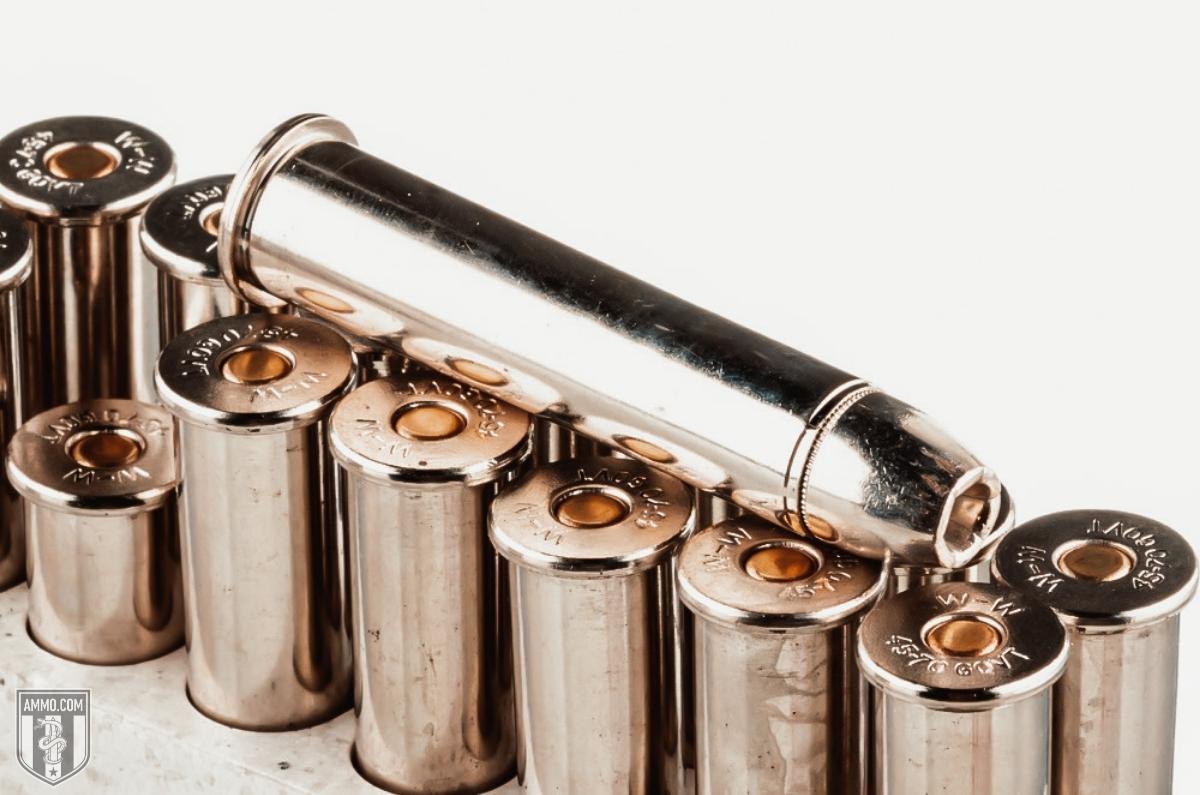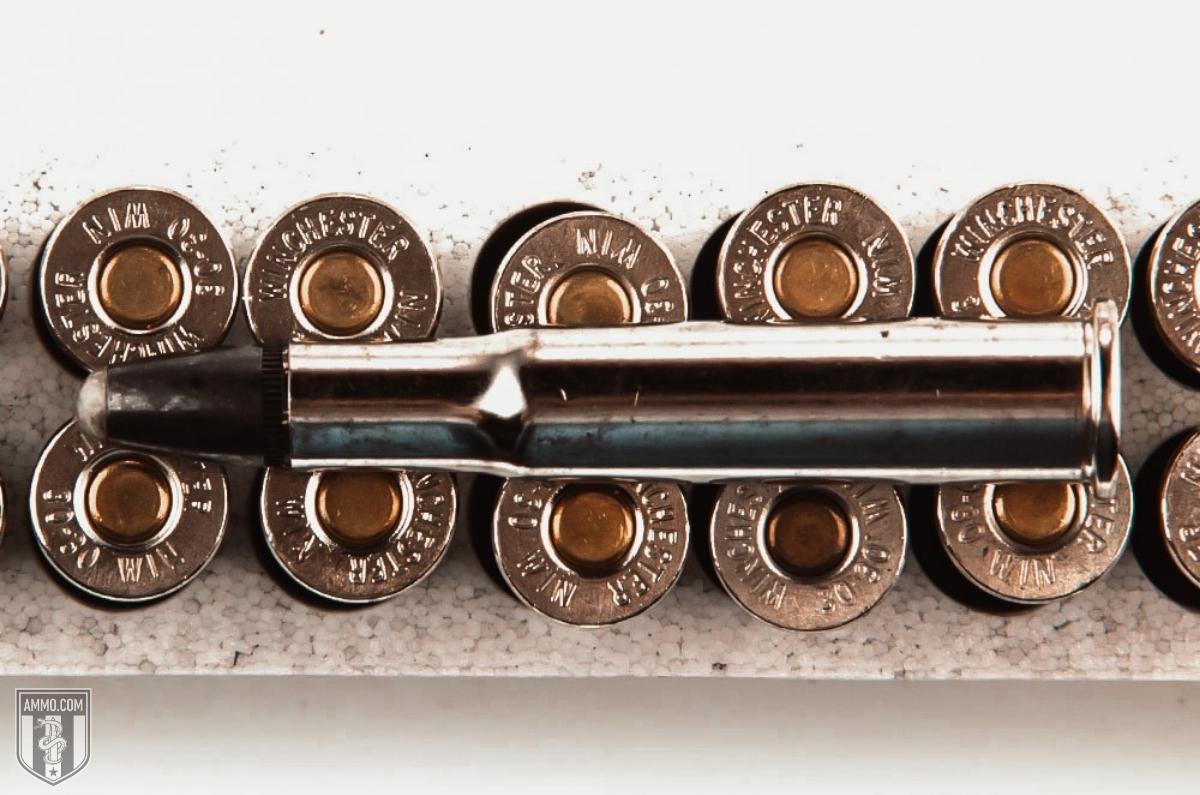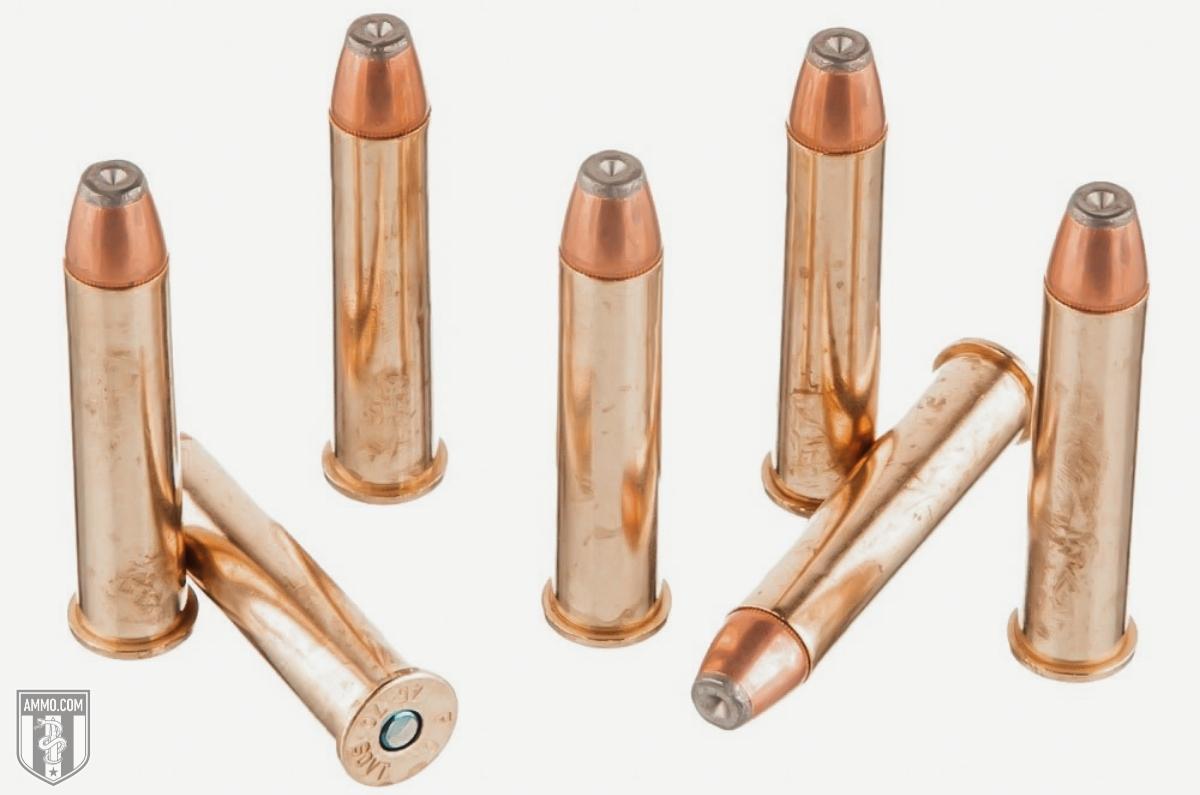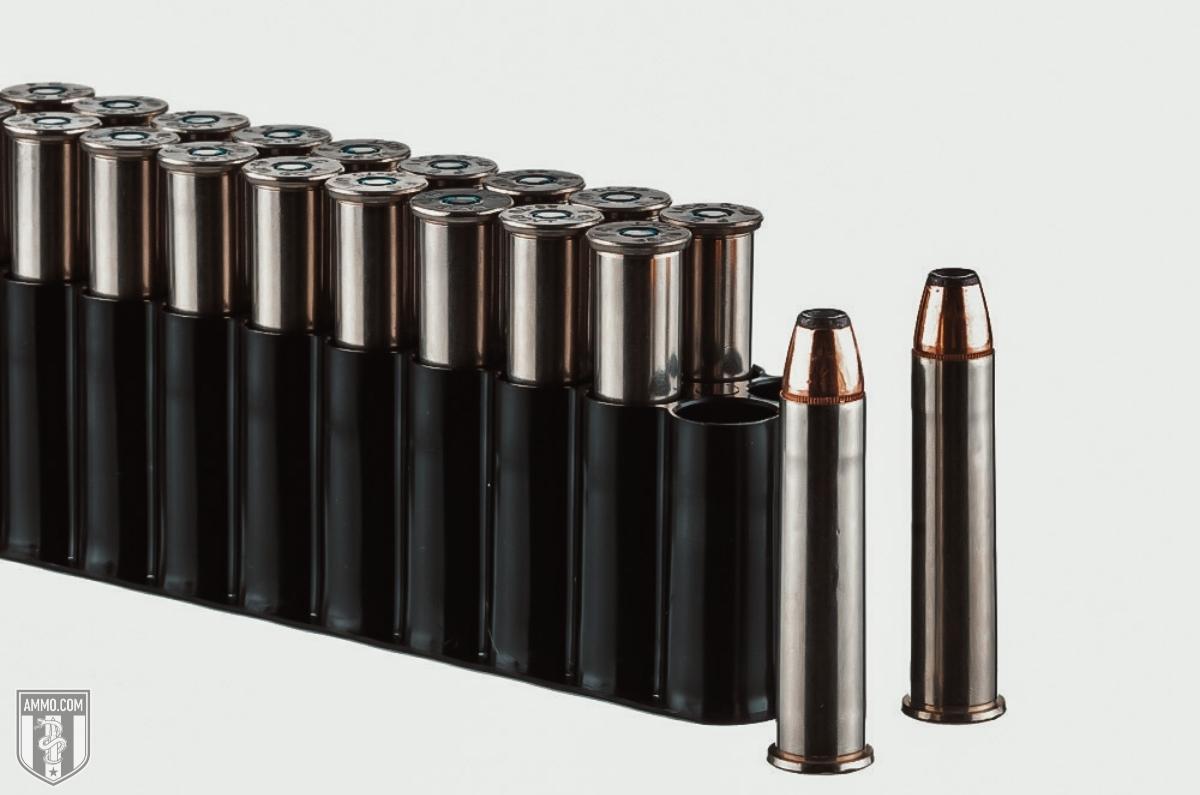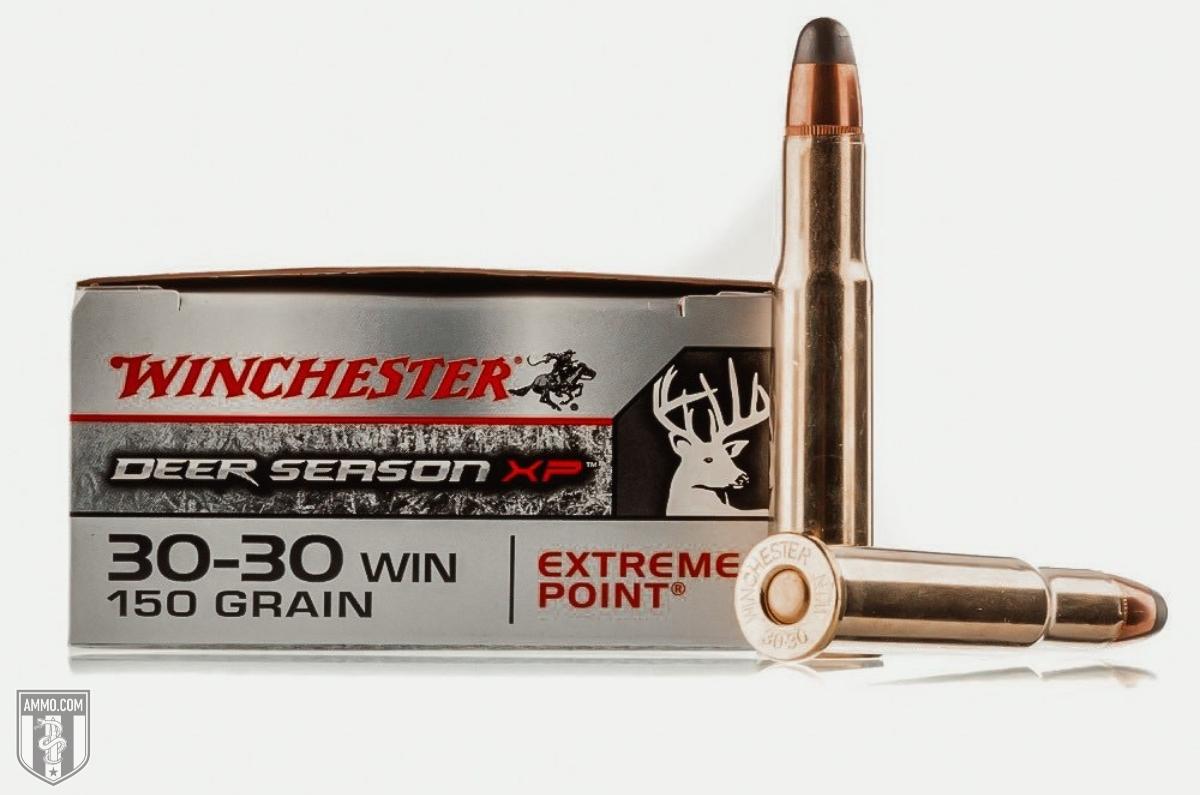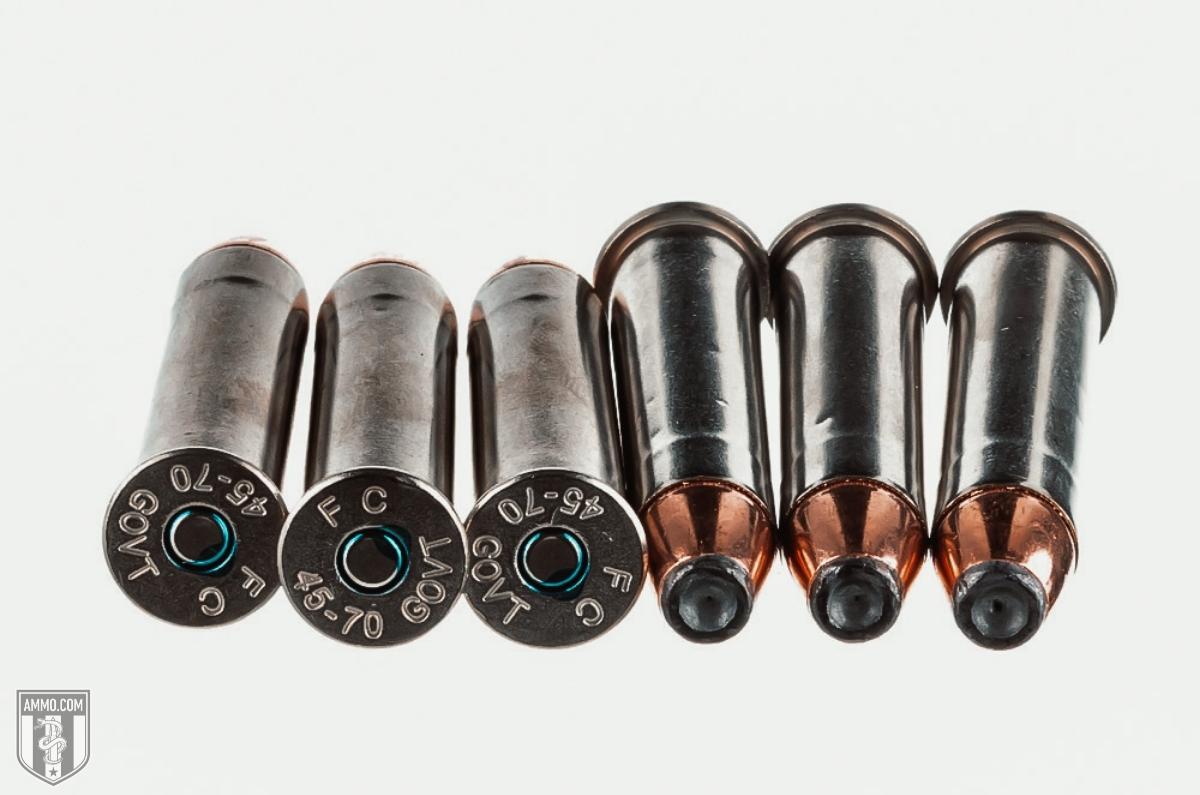45-70 vs. 30-30: For the Love of a Lever Gun
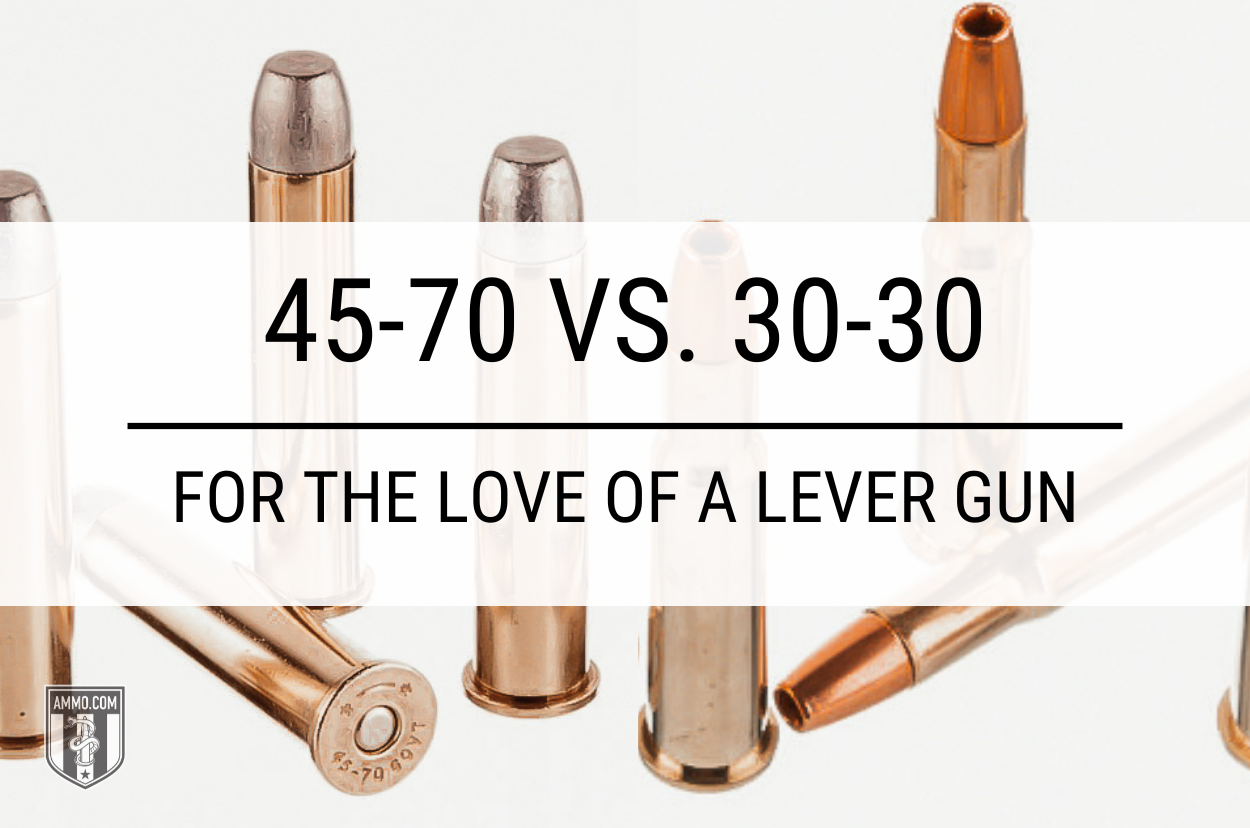
There’s something deliciously nostalgic about lever-action rifles. They have an aura and mystique about them, especially when you use one as a hunting rifle. It’s as though you’ve been transported back to a simpler time when the big game freely roamed the forests and Great Plains of North America.
There are many rifle cartridges you can select if you want to pick up a lever gun. Two of the most popular are the 30-30 Winchester and the 45-70 Government.
The 45-70 is a big, beefy cartridge that hits hard and has the power to take down a grizzly. The 30-30 is lighter, more nimble, and a lot gentler on the shoulder.
Both cartridges have a long and impressive history of getting the job done when it comes to putting meat on the table. But which one is right for you?
In this article, we will analyze the rounds’ relative advantages and disadvantages so you can make the best decision on your next lever-action hunting rifle.
What’s the Difference Between 45-70 vs. 30-30?
The primary difference between 45-70 vs. 30-30 is that the 30-30 Win cartridge fires a 0.308” diameter bullet while the 45-70 Govt fires a 0.458” diameter bullet. Both cartridges can be used on medium game like whitetail, hogs, or black bear, but the 45-70 can take on big game animals like brown bear, bison, and moose.
Cartridge Specs
When comparing two rifle cartridges, it’s a good idea to gain more knowledge of each by analyzing the cartridges’ specs.
The first and most obvious difference between 45-70 and 30-30 is the size of the bullet each fires. The 45-70 fires a 0.458” diameter bullet, while the 30-30’s 0.308” diameter bullet makes it a true American .30 caliber. This means the 45-70 Govt fires larger, heavier bullets than the 30-30.
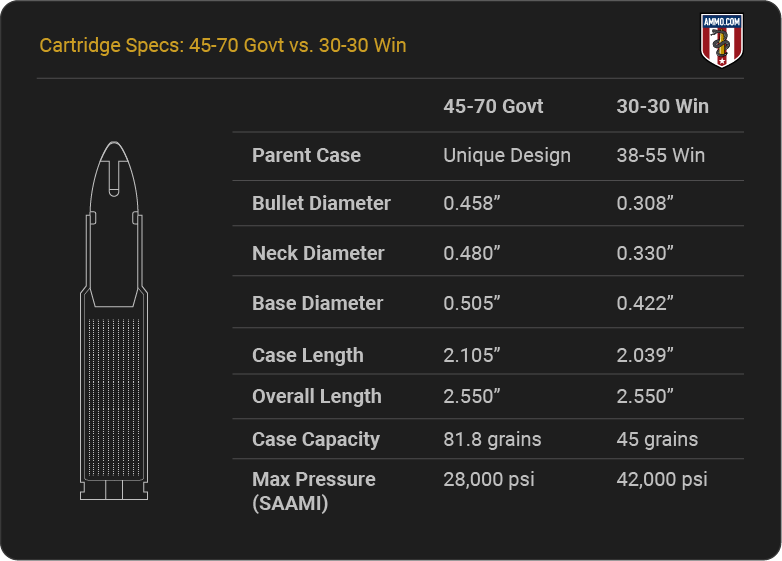
Another significant difference between the two cartridges is their size. The 45-70 is wider (albeit the same length). Their designs are different as well, as the 45-70 has a straight-walled case while the 30-30’s is bottle-necked (like the 223 Remington).
The larger 45-70 has almost double the case capacity of the 30-30 (81 vs. 45 grains, respectively). Its larger case capacity is needed for launching the 300+ grain weight boulders – or, rather, bullets – the 45-70 fires.
There’s no denying that the 45-70 is a monster of a round, but all that power comes at the cost of greater recoil.
There’s no denying that the 45-70 is a monster of a round, but all that power comes at the cost of felt reoil.
Recoil
Felt recoil varies depending on the shooter and rifle. A heavier rifle has less felt recoil than a lighter one, as its greater mass absorbs more recoil energy.
On average, the 30-30 has around 14 ft-lbs of recoil energy, whereas the 45-70 imparts around 33 ft-lbs of energy to a shooter’s shoulder. That’s over double!
Most shooters utilize these rounds for deer hunting and other big game. Recoil should therefore not be a huge issue, as most hunters take one or two shots tops during a trip into the woods. Even so, the 30-30 is the superior choice as far as recoil is concerned.
Trajectory
Trajectory is how we quantify a bullet’s flight path as it travels downrange, measured in inches of drop.
A flatter-shooting cartridge is preferable for shooting longer ranges, it requires the shooter to make fewer adjustments to compensate for bullet drop. Having a flatter trajectory also means that a cartridge will be more forgiving of ranging mistakes.
Neither the 30-30 nor 45-70 are known for having exceptionally flat trajectories. As such, it is not advisable to use them for longer range shots. (For shots over 300 yards, the 300 Winchester Magnum or 6.5 Creedmoor would be a better option.
The steeper bullet drop rates seen in 30-30 Winchester and 45-70 Government are due to the bullet designs required for lever-action rifles; either round’s bullet is obligated to have a flat or round nose. As these bullet profiles are less aerodynamic than a spitzer alternative, they rapidly hemorrhage velocity in flight. As the bullets lose velocity, gravity has more time to pull them toward the ground.
Looking at the ballistics tables below, we can see that the 30-30 has a flatter trajectory than 45-70 for virtually every loading. This is thanks to its lighter bullets and higher muzzle velocities.
Ballistic Coefficient
The ballistic coefficient (BC) measures how well a bullet resists wind drift and air resistance. Put another way, it’s a numeric representation of how aerodynamic a bullet is. A high BC is preferable as it means the bullet will buck the wind more easily.
Ballistic coefficient varies from bullet to bullet based on design, weight, and other factors that are beyond the scope of this article. That said, heavier bullets generally have a higher BC, as it takes more force to disrupt their flight compared to lighter ones.
Take the Remington Core-Lokt round, for example: an effective and inexpensive soft point hunting load that can be found in almost all sporting goods stores across North America. A 30-30 Core-Lokt round with a 170 grain bullet has a BC of 0.254, whereas a 405 grain 45-70 Core-Lokt load has a BC of 0.281.
It would be easy to surmise that the 45-70’s characteristically heavier bullets have higher BCs than the 30-30. However, doing so would completely ignore bullet design, which also plays a sizable role in the ballistic coefficient equation.
Hornady LEVERevolution 30-30 160 grain FTX has a BC of 0.330, while the same label’s 45-70 325 grain FTX has a lower BC of 0.230.
This exception notwithstanding, the 45-70 typically has a slight edge over the 30-30 in terms of ballistic coefficient due to the heavier bullets it fires.
Sectional Density
Sectional Density (SD) is a measure of how well a bullet penetrates a target. This is extremely important when hunting big and medium game, as you need a bullet that can punch through thick hide, bone, and sinew.
A bullet’s SD is a product of its weight and diameter. The higher its SD, the deeper the bullet will penetrate into the target. (This is a simplified view of penetration, as there are other factors to consider such as bullet expansion and velocity, though SD is illustrative all the same).
The 45-70 is well known for its penetration as it is routinely used to hunt big game like elk, moose, and brown bear with excellent results.
However, the 30-30 is no slouch when it comes to penetration, as it has remained one of the top rounds for deer hunting since its release.
Shooters might surmise that the 45-70 has a higher SD as it fires heavier and wider bullets. Doing so would overlook the 30-30’s tendency to localize its force into a smaller area, which also aids with deeper penetration.
Although every factory load is different, on average, the 45-70 and 30-30 have similar sectional densities.
Hunting
The 30-30 and 45-70 are both excellent choices for harvesting medium and large game.
The 30-30 Winchester is best for:
- Deer
- Hogs
- Black bear
The 45-70 Govt is best for:
- Elk
- Grizzly bear
- Moose
As a rule of thumb, it takes 1,000 ft-lbs of energy to ethically harvest a whitetail deer. The 30-30 Winchester starts to dip below this level at around 200 yards; the 45-70 Govt, around 300 yards (for hotter loads). Its arching trajectory to 300 yards makes shooting long distances with the 45-70 difficult, and something that must be practiced before setting foot into the woods.
As responsible hunters, it's our duty to make sure that we limit the suffering of any game animal we take aim at.
For smaller game, you want something with a flatter trajectory and smaller bullet, such as a 223 Remington or 22-250 Rem. A 30-30 would be effective against a coyote or groundhog, although it's a bit too much for pest control (if you want to preserve pelts, at least).
Speaking of overkill, some hunters claim that the 45-70 is too much for whitetail, suggesting that using a larger round will destroy the meat and “there’ll be nothing left.” These claims are wildly exaggerated, as the 45-70 has been used to harvest deer for over a century without issue. It leaves plenty left to eat, I assure you. If you like your 45-70 lever gun or single-shot rifle and want to go hunting with it, then go for it. Don’t let anyone tell you otherwise.
To summarize, 30-30 is an excellent choice for deer and black bear. The 45-70 can also handle these, as well as big game like moose and brown bear.
Reloading
Handloaders have created their own custom ammo for both of these rifle cartridges for decades. There has been extensive load development for both rounds, and there are now plenty of powders and bullets to choose from.
Handloading 30-30 allows you to stockpile more common 0.308” diameter bullets. These are extremely popular among North American hunters who characteristically favor cartridges like 308 Winchester, 300 Win Mag, and 30-06 Springfield. Having a commonality between the cartridges you handload for makes it easier to source components, as you can buy in bulk.
The 0.458” diameter bullet is somewhat less common, although there are still plenty of options available to help you tailor the perfect 45-70 handload for your rifle.
Reloading helps reduce your overall ammo cost. And if you enjoy plinking or going to the range frequently, it can be a real windfall for your wallet. Furthermore, there’s something satisfying about creating and shooting your own handloads that you don’t get when you shoot factory ammo.
Ballistics: 30-30 vs 45-70
The Ammo.com team has scoured the internet to bring you extremely comprehensive ballistics tables for both cartridges. Below are tables that compare bullet weight to muzzle velocity, kinetic energy, and trajectory for both 30-30 and 45-70.
.30-30 Ballistics Chart
Note: This information comes from the manufacturer and is for informational purposes only. The actual ballistics obtained with your firearm can vary considerably from the advertised ballistics. Also, ballistics can vary from lot to lot with the same brand and type load.
| 30-30 Bullet Weight | Muzzle VELOCITY (fps) | Muzzle ENERGY (ft. lbs.) | TRAJECTORY (in.) | |||||||||||
|---|---|---|---|---|---|---|---|---|---|---|---|---|---|---|
| Muzzle | 100 yds. | 200 yds. | 300 yds. | 400 yds. | Muzzle | 100 yds. | 200 yds. | 300 yds. | 400 yds. | 100 yds. | 200 yds. | 300 yds. | 400 yds. | |
| 55 Grain | 3400 | 2693 | 2085 | 1570 | 1187 | 1412 | 886 | 521 | 301 | 172 | 2 | 0 | -10.2 | -35 |
| 125 Grain | 2570 | 2090 | 1660 | 1320 | 1080 | 1830 | 1210 | 770 | 480 | 320 | -2 | -2.6 | -19.9 | 0 |
| 140 Grain | 2500 | 2198 | 1918 | 1662 | n/a | 1943 | 1501 | 1143 | 858 | n/a | 2.9 | 0 | -12.4 | n/a |
| 150 Grain | 2390 | 2040 | 1723 | 1447 | 1225 | 1902 | 1386 | 989 | 697 | 499 | 0 | -7.5 | -27 | -63 |
| 150 Grain Supreme | 2480 | 2095 | 1747 | 1446 | 1209 | 2049 | 1462 | 1017 | 697 | 487 | 0 | -6.5 | -24.5 | 0 |
| 160 Grain | 2300 | 1997 | 1719 | 1473 | 1268 | 1879 | 1416 | 1050 | 771 | 571 | 2.5 | -2.9 | -20.2 | 0 |
| 160 Grain Lever Evolution | 2400 | 2150 | 1916 | 1699 | n/a | 2046 | 1643 | 1304 | 1025 | n/a | 3 | 0.2 | -12.1 | n/a |
| 170 Grain PMC Cowboy | 1300 | 1198 | 1121 | n/a | n/a | 638 | 474 | n/a | n/a | n/a | 0 | -27 | 0 | 0 |
| 170 Grain | 2200 | 1895 | 1619 | 1381 | 1191 | 1827 | 1355 | 989 | 720 | 535 | 2.5 | -5.8 | -23.6 | 0 |
Take a deep dive into 30-30 ballistics for factory ammo.
45-70 Ballistics Chart
Note: This information comes from manufacturers. Actual ballistics obtained with your firearm can vary considerably from advertised ballistics. Also, ballistics can vary from lot to lot with the same brand and type load.
| 45-70 Bullet Weight | VELOCITY (fps) | ENERGY (ft-lbs) | TRAJECTORY (in.) | |||||||||||
|---|---|---|---|---|---|---|---|---|---|---|---|---|---|---|
| Muzzle | 100 yds. | 200 yds. | 300 yds. | 400 yds. | Muzzle | 100 yds. | 200 yds. | 300 yds. | 400 yds. | 100 yds. | 200 yds. | 300 yds. | 400 yds. | |
| 250 Grain | 2025 | 1616 | 1285 | 1068 | n/a | 2276 | 1449 | 917 | 634 | n/a | 6.1 | 0 | -27.2 | n/a |
| 300 Grain | 1810 | 1497 | 1244 | 1073 | 969 | 2182 | 1492 | 1031 | 767 | 625 | 0 | -14.8 | 0 | 0 |
| 300 Grain Supreme | 1880 | 1558 | 1292 | 1103 | 988 | 2355 | 1616 | 1112 | 811 | 651 | 0 | -12.9 | -46 | -105 |
| 325 Grain | 2000 | 1685 | 1413 | 1197 | n/a | 2886 | 2049 | 1441 | 1035 | n/a | 5.5 | 0 | -23 | n/a |
| 325 Grain Lever Evolution | 2050 | 1729 | 1450 | 1225 | n/a | 3032 | 2158 | 1516 | 1083 | n/a | 3 | -4.1 | -27.8 | n/a |
| 405 Grain | 1330 | 1168 | 1055 | 977 | 918 | 1590 | 1227 | 1001 | 858 | 758 | 0 | -24.6 | 0 | 0 |
| 405 Grain PMC Cowboy | 1550 | 1193 | n/a | n/a | n/a | 1639 | 1280 | n/a | n/a | n/a | 0 | -23.9 | 0 | 0 |
Take a deep dive into 45-70 ballistics for factory ammo.
A Brief History of 30-30 Winchester
The 30-30 Winchester is one of America’s oldest hunting cartridges. It was developed by Winchester Repeating Arms Company and released in their catalog in August, 1895. The new round was marketed as a sporting cartridge and chambered in Winchester’s Model 1894 carbine. Alongside the 25-35 Win, the 30-30 Win was the first small-bore hunting cartridge designed for smokeless propellant (as opposed to black powder).
The 30-30 Winchester has also been known as:
- 30 Winchester Center Fire
- 30 WCF
- 30 Winchester Smokeless
The 30 WCF offered hunters excellent terminal ballistics in a smooth, compact package. Ideal for deer hunting and target shooting, the 30 WCF has remained extremely popular since its debut well into the modern era.
When Marlin adopted the 30 WCF for their model 336 lever action, they didn’t want to pay homage to Winchester as they were a rival gun manufacturer.
As such, they dropped “Winchester” from the name and simply called it the 30-30. Pronounced “thirty thirty,” this nomenclature harkens back to an older methodology of cartridge naming.
The first “30” in the name refers to the cartridge’s caliber, while the second “30” refers to the 30 grains of smokeless powder used in the original design.
If you’d like to learn more about how the 30-30 Win compares to other cartridges, check out 30-30 vs. 30-06 and 30-30 vs. 7.62x39!
A Brief History of 45-70 Government
The years following the American Civil War were a renaissance period for developments in metallic cartridge technology. One of the greatest cartridges to emerge from that era was the 45-70 Government. Released in 1873, the .45-70 was developed by the U.S. Army’s Springfield Armory for their new Model 1873 rifle, which came to be known as the “Trapdoor Springfield.”
The new cartridge carried the designation .45-70-405, which uses older cartridge naming conventions.
- .45 designates the nominal bore diameter
- 70 refers to the 70 grains of black powder
- 405 refers to the 405 grain bullet the cartridge was originally designed to fire
The original Springfield load was designed to fire a 405 grain lead flat nose bullet at nearly 1,400 fps muzzle velocity and with 1,748 ft-lbs of muzzle energy. Although these numbers are not impressive by modern 45-70 loads (which can exceed 2,200 fps muzzle velocity and 3,400 ft-lbs muzzle energy), it’s important to remember that the original loads utilized black powder as opposed to the modern era’s far more potent smokeless propellant.
Pronounced “forty-five seventy”, the 45-70 is also known as the .45-70 Government (Govt). The 45-70 and Trapdoor Springfield served as the primary rifle for the U.S. Army until its replacement by the bolt action 30-40 Krag–Jørgensen in 1893.
The 45-70 has made a name for itself as a potent guide gun cartridge and is frequently carried by hunters going into bear country for personal protection. Buffalo Bore 45-70 Magnum ammo is an excellent choice if you expect grizzlies to wander about in your hunting grounds. Fired from your Marlin or Henry carbine, its 2,000 fps and 3,500 foot-pounds of energy will make any bear think twice about making you dinner!
Although many modern hunting cartridges may have superior ballistics and flatter trajectories, there’s something special and satisfying about carrying a heavy-hitting 45-70 lever gun into the woods. You’ll know you’re ready for any critter that crosses your path.
Final Shots: 45-70 vs 30-30
When it comes to hunting cartridges, the extremely effective 30-30 Winchester and 45-70 Government cannot be ignored. With over a century of service, the 30-30 and 45-70 have survived the test of time, and their popularity among shooters is not waning any time soon.
The lower-recoil 30-30 Winchester makes a fine choice for black bear or deer hunting. Its lower cost per round also makes it the better choice if you enjoy plinking or just spending an afternoon at the range without blowing holes through your wallet.
The 45-70 Government is a hard-hitting cartridge that can take down some of the most dangerous game in North America. Its bone-crushing energy makes it deadly on whitetail deer or elk within 200 yards.
However, it does have over double the ft-lbs of recoil and price than the 30-30.
Which round is better for you depends on your intended purpose for the rifle.
If you love big game hunting – or will be wandering through bear territory – you’ll want a Marlin or Henry lever-action rifle chambered in 45-70.
If you only plan on hunting hogs, whitetail deer, or just plinking with a lever gun, then the 30-30 will be more than enough. However, the 30-30 is not powerful enough to hunt moose or brown bears.
If your goal isn’t big game hunting, then the choice is completely up to you. Some shooters just love the heft of an 1874 Sharps and the thump of a 45-70. Some get their kicks from actuating the lever action on their Marlin 336 in 30-30.
There’s nothing wrong with either. In this case, it’s more about what makes you happy as a shooter than which is the “better cartridge.”
Whichever round you choose, make sure you stock up on ammo here at Ammo.com so that you are ready to flex your 2A rights and your love of lever guns.
Ammo Comparisons
- .308 vs 5.56
- 6.5 Creedmoor vs .308
- .300 Blackout vs .308
- .300 Win Mag vs .308
- .243 vs .308
- .308 vs .30-06
- 7mm-08 vs .308
- .270 vs .308
- 7.62x39 vs .308
- .223 vs .308
- .338 Lapua vs .308
- .380 ACP vs 9mm
- .223 vs 5.56
- .300 Blackout vs 5.56
- 9mm vs 45 ACP
- 9mm vs 40 S&W
- .357 SIG vs 9mm
- 10mm vs 9mm
- 9mm vs 9mm Luger
- .243 vs .270
- .300 Win Mag vs .30-06
- .270 vs .30-06
- .40 vs .45
- 38 Special vs 357
- 9mm vs 40 vs 45
- 5.56 vs 7.62x39
- 338 Lapua vs .30-06
- .30-30 vs .30-06
- 300 PRC vs 338 Lapua
- .30-06 vs 7mm
- 300 Win Mag vs 338 Lapua
- 300 PRC vs 300 Win Mag
- 300 WSM vs 300 Win Mag
- 338 Win Mag vs 338 Lapua
- 12 Gauge vs 20 Gauge
- 10mm vs 357 Mag
- .30-30 vs 7.62x39
- 224 Valkyrie vs 22-250
- 17 HMR vs 22 Mag
- 7.62x39 vs .300 Blackout
- 45 ACP vs 45 Auto
- 45-70 vs 30-30
- 300 Blackout vs 223
- 357 Magnum vs 9mm
- 350 Legend vs 300 Blackout
- 224 Valkyrie vs 223
- 45 ACP vs 38 Super
- 6.5 Grendel vs .308
- 17 HMR vs 22 LR
- 10 Gauge vs 12 Gauge
- 22-250 vs 223
- 45 Colt vs 45 ACP
- 350 Legend vs 30-30
- 5.7x28 vs 223
- 5.7 vs 9mm
- 5.56 vs 5.7
- 22 vs 9mm
- Buckshot vs Birdshot
- 450 Bushmaster vs 308
- 450 Bushmaster vs 223
- Buckshot vs Slug
- 6.5 Grendel vs 5.56 vs 223
- 6mm ARC vs 6.5 Grendel
- 44 vs 45
- 458 SOCOM vs 5.56
- 357 vs 44
- 32 ACP vs 380
- 300 Win Mag vs 338 Win Mag vs 338 Lapua Mag
- 450 Bushmaster vs 458 SOCOM vs 50 Beowulf
- 6mm Creedmoor vs 6.5 Creedmoor
- TMJ vs FMJ
- 44 Special Vs 44 Magnum
- 45 90 vs 45 70
- 6.8 Western vs 6.8 SPC
- 50 Beowulf vs 50 BMG
- 26 Nosler vs 6.5 PRC
- 28 Gauge vs 410
- 6.8 SPC vs 5.56
- 6.8 SPC vs 6.5 Grendel
- 6.8 Western vs 7mm Rem Mag vs .28 Nosler
- 6.8 Western vs 6.5 Creedmoor
- 22 Hornet vs 223
- 6.8 Western vs 6.5 PRC
- .410 vs 12 Gauge
- .410 vs 20 Gauge
- 22 LR vs 22 Mag
- 6mm ARC vs 243
- 7mm-08 vs 270
- 243 vs 6.5 Creedmoor
- Nickel vs Brass Casing
- 204 Ruger vs 223
- 50 Beowulf vs 5.56
- 260 Remington vs 6.5 Creedmoor
- 6mm Remington vs 243
- 28 Nosler vs 300 PRC
- 50 Beowulf vs 50 AE
- 22 Nosler vs 22-250
- 450 Marlin vs 45-70
- 300 Win Mag vs 300 Norma
- 458 SOCOM vs 300 Blackout
- 38-55 vs 45-70
- 22 Hornet vs 22 LR
- 300 Norma vs 338 Lapua
- 338 Lapua vs 50 BMG
- 28 Nosler vs 300 Win Mag
- 28 Nosler vs 6.5 Creedmoor
- 204 vs 22-250
- 458 SOCOM vs 45 70
- 44 40 vs 45 70
- 6.8 SPC vs 6.5 Creedmoor
- 450 Bushmaster vs 30-06
- 7mm Rem Mag vs 300 Win Mag
- 30 Carbine vs 223
- 25-06 vs 30-06
- 26 Nosler vs 28 Nosler
- 16ga vs 12ga
- 30 06 vs 7.62 x54R
- 9mm Makarov vs 9mm Luger
- 350 Legend vs 223
- 30 Carbine vs 5.56
- 6.5x55 vs 6.5 Creedmoor
- 6.5 Creedmoor vs 270 vs 25-06
- M193 vs M855
- 450 Bushmaster vs 458 SOCOM
- 6.5 Grendel vs 6.5 Creedmoor
- 350 Legend vs 5.56
- .277 Fury vs 6.8 SPC
- 277 Fury vs 300 Win Mag
- 10mm vs .45 ACP
- 277 Fury vs 223
- 6.8 SPC vs 300 Blackout
- 6.5 PRC vs 6.5 Creedmoor
- 277 Fury vs 308
- 277 Fury vs 6.5 Creedmoor
- 350 Legend vs 450 Bushmaster
- 277 Fury Vs 5.56 NATO
- 10mm vs 40S&W
- 32 ACP vs 9mm
- 32 Special vs 9mm
- 8.6 Blackout vs 300 Blackout
- 30 Super Carry vs. 9mm
- 5.56 vs 9mm
- .50 Action Express vs 9mm
- 7.62x25 vs. 9mm
- 10mm vs 44 Magnum
- 300 Blackout vs 300 Win Mag
- 6.5 Grendel vs 300 Blackout
- 460 Rowland vs 10mm
- 300 RUM vs 300 PRC
- 300 Norma vs 300 PRC
- 45 GAP vs 45 ACP
- 7mm PRC vs 300 Win Mag
- 300 PRC vs 6.5 Creedmoor
- 300 PRC vs 308
- 357 SIG vs 357 Mag
- 7.62x39 vs 7.62x51
- 243 Win vs 223 Rem
- 30 Nosler vs 300 PRC
- 6.5 Creedmoor vs. 30-06 Springfield
- 450 S&W vs. 44 Magnum
- 6.5 Creedmoor vs. 300 Win Mag
- 454 Cassull vs. 45-70 Govt
- 454 Cassull vs. 44 Mag
- 7.62x54r vs. 308 Winchester
- 22 ARC vs. 223 Rem
- Subsonic vs. Supersonic Ammo

